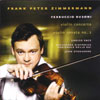Busoni Violin Concerto; Violin Sonata No 2
The concerto you either love or hate but the violinist comes up trumps
View record and artist detailsRecord and Artist Details
Composer or Director: Ferruccio (Dante Michelangiolo Benvenuto) Busoni
Label: Sony Classical
Magazine Review Date: 7/2006
Media Format: CD or Download
Media Runtime: 54
Mastering:
Stereo
DDD
Catalogue Number: SK94497

Tracks:
| Composition | Artist Credit |
|---|---|
| Concerto for Violin and Orchestra |
Ferruccio (Dante Michelangiolo Benvenuto) Busoni, Composer
Ferruccio (Dante Michelangiolo Benvenuto) Busoni, Composer Frank Peter Zimmermann, Violin John Storgårds, Conductor RAI National Symphony Orchestra |
| Sonata for Violin and Piano No. 2 |
Ferruccio (Dante Michelangiolo Benvenuto) Busoni, Composer
Enrico Pace, Piano Ferruccio (Dante Michelangiolo Benvenuto) Busoni, Composer Frank Peter Zimmermann, Violin |
Author: Rob Cowan
Frank Peter Zimmermann performs an inestimable service by coupling two of the most approachable works by a master too often sidelined as excessively prolix. Prior to hearing this assured and musically persuasive account of the Violin Concerto, only Joseph Szigeti (CBS, long unavailable) and Adolf Busch recorded live at the Concertgebouw in the late 1930s (Q-Disc) have really made it work.
It’s an early piece, premiered in Berlin in 1897, a three-movement structure that plays without a break. Busoni himself called the Concerto ‘good…if unpretentious’, quietly original, too, though beam up 1’39” and you’ll hear a short passage that replicates almost to the note the transition from first to second subjects in the first movement of Brahms’s Violin Concerto. Busoni’s Concerto is at its darkest in the Quasi andante where solo and orchestral voices are beautifully integrated, at 4’25” for example, where the violin plays a two-note phrase that speeds by phases into a trill, and the woodwinds take up the phrase beneath him. The bustling finale is filled with typically Busonian playfulness, felicitously scored music that’s stylishly played by Zimmermann – his tonal polish and technical mastery reminding me at times of both Milstein and David Oistrakh.
The half-hour Violin Sonata, a seminal piece from 1900, opens more like the Busoni we know and love (or not, as the case may be) and owes an obvious debt to both Beethoven and Schubert. My previous favourite digital version, by Gidon Kremer and Valery Afanassiev (DG, 12/88 – nla), slows the journey by some eight minutes but Zimmermann’s faster speeds in no way compromise the work’s profound impact.
The first movement is mostly sombre and austere, the Scherzo a manic tarantella, then after a brief slow movement there’s a set of variations based on a chorale-like theme, a world on its own that incorporates elements of dance, fugue and virtuoso display. The transition to the closing Allegro unmistakably echoes Schubert’s great C major Fantasy. Again Zimmermann comes up trumps with a modern benchmark, matched in spirit and expertise by his pianist Enrico Pace. A marvellous disc, this, not to be missed on any count.
It’s an early piece, premiered in Berlin in 1897, a three-movement structure that plays without a break. Busoni himself called the Concerto ‘good…if unpretentious’, quietly original, too, though beam up 1’39” and you’ll hear a short passage that replicates almost to the note the transition from first to second subjects in the first movement of Brahms’s Violin Concerto. Busoni’s Concerto is at its darkest in the Quasi andante where solo and orchestral voices are beautifully integrated, at 4’25” for example, where the violin plays a two-note phrase that speeds by phases into a trill, and the woodwinds take up the phrase beneath him. The bustling finale is filled with typically Busonian playfulness, felicitously scored music that’s stylishly played by Zimmermann – his tonal polish and technical mastery reminding me at times of both Milstein and David Oistrakh.
The half-hour Violin Sonata, a seminal piece from 1900, opens more like the Busoni we know and love (or not, as the case may be) and owes an obvious debt to both Beethoven and Schubert. My previous favourite digital version, by Gidon Kremer and Valery Afanassiev (DG, 12/88 – nla), slows the journey by some eight minutes but Zimmermann’s faster speeds in no way compromise the work’s profound impact.
The first movement is mostly sombre and austere, the Scherzo a manic tarantella, then after a brief slow movement there’s a set of variations based on a chorale-like theme, a world on its own that incorporates elements of dance, fugue and virtuoso display. The transition to the closing Allegro unmistakably echoes Schubert’s great C major Fantasy. Again Zimmermann comes up trumps with a modern benchmark, matched in spirit and expertise by his pianist Enrico Pace. A marvellous disc, this, not to be missed on any count.
Discover the world's largest classical music catalogue with Presto Music.

Gramophone Digital Club
- Digital Edition
- Digital Archive
- Reviews Database
- Full website access
From £8.75 / month
Subscribe
Gramophone Full Club
- Print Edition
- Digital Edition
- Digital Archive
- Reviews Database
- Full website access
From £11.00 / month
Subscribe
If you are a library, university or other organisation that would be interested in an institutional subscription to Gramophone please click here for further information.




